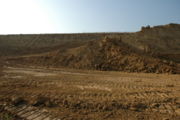
Loam
Encyclopedia

Soil
Soil is a natural body consisting of layers of mineral constituents of variable thicknesses, which differ from the parent materials in their morphological, physical, chemical, and mineralogical characteristics...
composed of sand
Sand
Sand is a naturally occurring granular material composed of finely divided rock and mineral particles.The composition of sand is highly variable, depending on the local rock sources and conditions, but the most common constituent of sand in inland continental settings and non-tropical coastal...
, silt
Silt
Silt is granular material of a size somewhere between sand and clay whose mineral origin is quartz and feldspar. Silt may occur as a soil or as suspended sediment in a surface water body...
, and clay
Clay
Clay is a general term including many combinations of one or more clay minerals with traces of metal oxides and organic matter. Geologic clay deposits are mostly composed of phyllosilicate minerals containing variable amounts of water trapped in the mineral structure.- Formation :Clay minerals...
in relatively even concentration (about 40-40-20% concentration respectively). Loam soils generally contain more nutrients and humus than sandy soils, have better infiltration and drainage than silty soils, and are easier to till
Tillage
Tillage is the agricultural preparation of the soil by mechanical agitation of various types, such as digging, stirring, and overturning. Examples of human-powered tilling methods using hand tools include shovelling, picking, mattock work, hoeing, and raking...
than clay soils. Loams are gritty, moist, and retain water easily.
Although people who are uninformed might ask for topsoil
Topsoil
Topsoil is the upper, outermost layer of soil, usually the top to . It has the highest concentration of organic matter and microorganisms and is where most of the Earth's biological soil activity occurs.-Importance:...
, in fact loam would be the more desirable medium for growing most crops and grasses. Loam is considered ideal for gardening and agricultural uses because it retains nutrients well and retains water while still allowing the water to flow freely. This soil is found in a majority of successful farms in regions around the world known for their fertile land. Loam soil feels soft and rich and is easy to work over a wide range of moisture conditions.There are many different types of loam soils, each with slightly different characteristics, and with some draining liquids more efficiently than others.
Different proportions of sand, silt, and clay give rise to types of loam soils: sandy loam, silty loam, clay loam, sandy clay loam, silty clay loam, and loam. A soil dominated by one or two of the three particle size groups can behave like loam if it has a strong granular structure, promoted by a high content of organic matter. However, a soil that meets the textural definition of loam can lose its characteristic desirable qualities when it is compacted, depleted of organic matter, or has clay dispersed throughout its fine-earth fraction.
Use in house construction
Loam may be used for the construction of houses. Construction crews can build a layer of loam on the inside of walls, which can help to control air humidity. Loam, combined with straw, can be used as a rough construction material to build walls. This is one of the oldest technologies for house construction in the world.See also
- Particle size (grain size)Particle size (grain size)Particle size, also called grain size, refers to the diameter of individual grains of sediment, or the lithified particles in clastic rocks. The term may also be applied to other granular materials. This is different from the crystallite size, which is the size of a single crystal inside the...
- Soil texture
- LoessLoessLoess is an aeolian sediment formed by the accumulation of wind-blown silt, typically in the 20–50 micrometre size range, twenty percent or less clay and the balance equal parts sand and silt that are loosely cemented by calcium carbonate...

